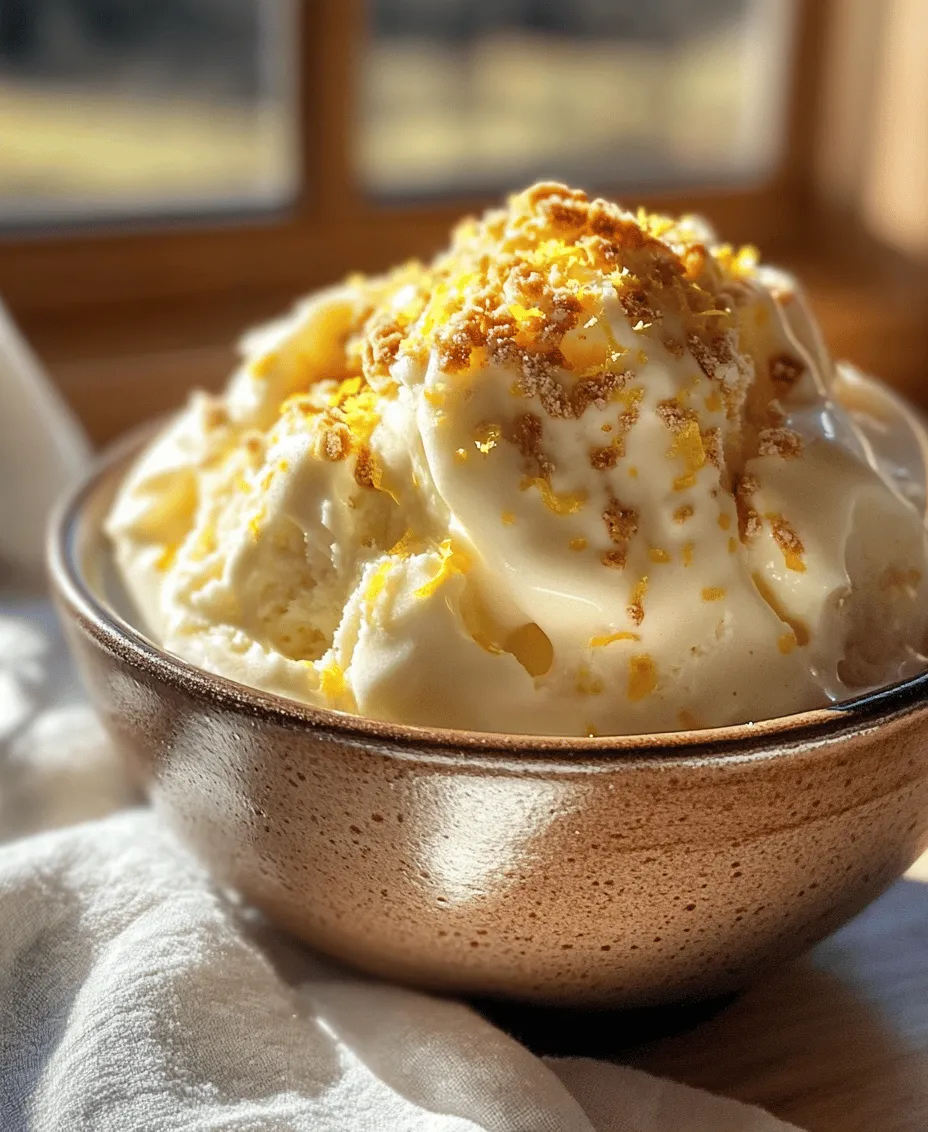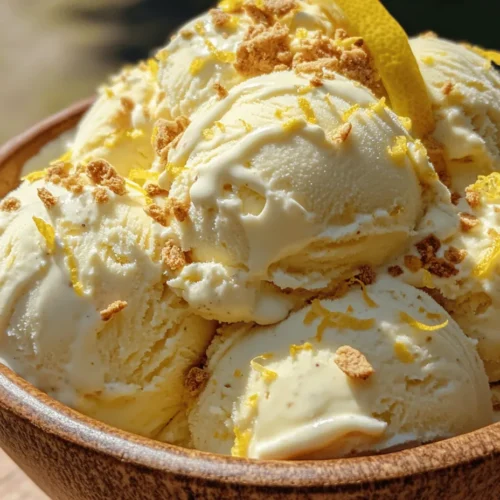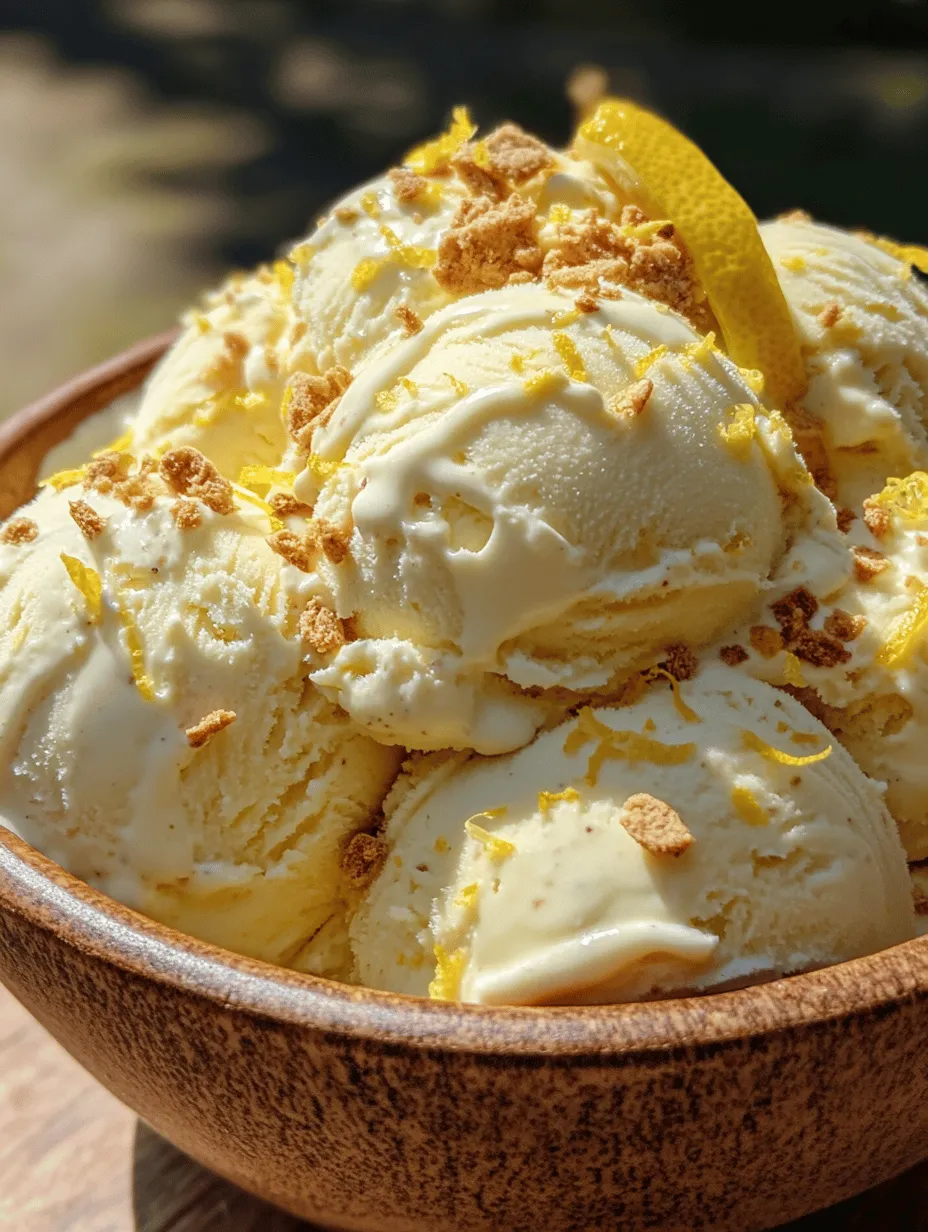Introduction
Homemade ice cream has surged in popularity in recent years, transforming from a nostalgic summer treat into a trendy culinary endeavor that many food enthusiasts tackle in their own kitchens. With the ability to control flavors, textures, and ingredients, making ice cream at home allows for endless creativity and personalization. One delightful flavor that stands out, especially during the warmer months, is lemon cheesecake. This unique combination of tangy lemon and rich, creamy cheesecake encapsulates the essence of summer, making it the perfect dessert to enjoy on a sunny day.
Imagine the refreshing zing of fresh lemons enveloped in a rich, creamy cheesecake base, creating a harmonious balance that tantalizes the taste buds. This Lemony Delight: Homemade Lemon Cheesecake Ice Cream recipe is not just a treat for ice cream lovers; it’s also a fantastic option for anyone seeking a light, refreshing dessert that captures the brightness of citrus. Not only is it a delicious indulgence, but it’s also surprisingly simple to make, requiring just a handful of ingredients and minimal equipment.
Whether you’re hosting a backyard barbecue, planning a picnic, or simply looking for a sweet way to cool down, this homemade lemon cheesecake ice cream will surely impress your family and friends. So, roll up your sleeves, and let’s dive into the refreshing world of homemade ice cream!
Understanding the Ingredients
To create the perfect lemon cheesecake ice cream, it’s essential to understand the role of each ingredient in this delightful recipe. Let’s take a closer look at these components and how they contribute to the overall flavor and texture of the ice cream.
Heavy Cream and Whole Milk
Heavy cream and whole milk are foundational ingredients that define the creaminess of the ice cream. The high-fat content in heavy cream provides a luxurious texture, while the whole milk adds just the right amount of liquid to ensure a smooth consistency. When combined, these two ingredients create a rich and creamy base that is essential for any ice cream recipe. The fat content also helps to prevent the formation of ice crystals, resulting in a silky-smooth final product.
Granulated Sugar
Sugar plays a critical role in balancing flavors. In this recipe, granulated sugar enhances the sweetness of the ice cream while countering the natural tartness of the lemon juice. The right amount of sugar not only sweetens the mixture but also contributes to the overall texture by lowering the freezing point, ensuring the ice cream remains scoopable once frozen.
Cream Cheese
The star ingredient in this recipe, cream cheese, is what gives the ice cream its signature cheesecake flavor. Its rich, tangy profile mirrors that of traditional cheesecake, creating a delightful creaminess that is hard to resist. Cream cheese also adds stability to the ice cream, ensuring it holds its shape when served. It’s important to use full-fat cream cheese for the best results, as low-fat varieties may not provide the same depth of flavor or texture.
Fresh Lemon Juice and Zest
For the most authentic lemon flavor, using fresh lemon juice and zest is non-negotiable. The juice provides the tartness that perfectly complements the sweetness of the sugar, while the zest adds aromatic oils that enhance the overall citrus profile. Fresh ingredients are key to achieving that vibrant and refreshing taste that makes this ice cream so special. Avoid bottled lemon juice, as it often lacks the brightness and complexity of fresh lemons.
Vanilla Extract and Salt
While vanilla extract is often seen as a supporting player in desserts, it plays an essential role in this recipe. The warmth of vanilla enhances the overall flavor, bringing all the components together harmoniously. A pinch of salt is equally important; it helps to elevate the sweetness and balance the tanginess of the lemon, creating a well-rounded taste experience.
Optional: Crushed Graham Crackers
If you want to take your lemon cheesecake ice cream to the next level, consider adding crushed graham crackers to the mixture. This optional ingredient not only adds a delightful crunch but also mimics the crust of a traditional cheesecake, providing a lovely texture contrast. Simply mix in the crushed graham crackers just before churning for the best results.
Step-by-Step Instructions for Making Lemon Cheesecake Ice Cream
Now that we’ve explored the essential ingredients, it’s time to get into the nitty-gritty of making this delicious lemon cheesecake ice cream. Follow these detailed steps to create a creamy, refreshing dessert that will impress everyone.
Preparation of the Base
1. Begin by Softening the Cream Cheese: Before you start mixing, it’s crucial to soften the cream cheese to ensure a smooth base. Remove the cream cheese from the refrigerator and let it sit at room temperature for about 30 minutes. Softened cream cheese will blend more easily with the sugar, resulting in a creamy texture.
2. Mix the Cream Cheese and Sugar: In a large mixing bowl, combine the softened cream cheese and granulated sugar. Using a hand mixer or a whisk, beat the two together until the mixture is smooth and free of lumps. This step is essential for creating a uniform base that will translate into a creamy ice cream texture.
Combining Ingredients
3. Incorporate the Remaining Ingredients: Once the cream cheese and sugar are well combined, it’s time to add the heavy cream, whole milk, fresh lemon juice, lemon zest, vanilla extract, and a pinch of salt. Using a spatula or a whisk, gently fold in the heavy cream and milk until fully incorporated. Be careful not to over-mix, as you want to maintain the airy texture of the cream.
4. Taste and Adjust: After mixing in all the ingredients, take a moment to taste the base. Depending on your preference, you might want to add a little more sugar or lemon juice. Remember, the flavors will become slightly muted once the mixture is frozen, so adjust accordingly.
Churning the Mixture
5. Chill the Mixture: For the best results, chill the mixture in the refrigerator for at least 2 hours, or ideally, overnight. This step allows the flavors to meld together and improves the overall texture of the ice cream.
6. Prepare Your Ice Cream Maker: If you’re using a traditional ice cream maker, make sure the bowl is correctly frozen if it requires pre-freezing. Follow the manufacturer’s instructions for your specific model.
7. Churn the Ice Cream: Pour the chilled mixture into the ice cream maker and churn according to the manufacturer’s instructions. Typically, this process takes about 20 to 30 minutes. Keep an eye on the consistency; you want it to resemble soft serve when done.
Freezing the Ice Cream
8. Transfer to a Freezer-Safe Container: Once the ice cream has reached the desired consistency, transfer it to a freezer-safe container. For an added cheesecake-like texture, consider folding in the crushed graham crackers at this stage.
9. Freeze Until Firm: Cover the container tightly and place it in the freezer for at least 4 hours, or until the ice cream is firm enough to scoop.
By following these steps, you’re well on your way to creating a refreshing and delightful homemade lemon cheesecake ice cream that is sure to be a hit this summer. Get ready to scoop and serve this unique treat that is bursting with flavor and perfect for warm weather enjoyment.

Once you’ve churned your luscious lemon cheesecake ice cream to perfection, it’s time to transfer it to an airtight container for freezing. This step is crucial for achieving that creamy, scoopable texture that we all love in homemade ice cream.
Transferring the Ice Cream
1. Airtight Container: Choose a container that’s suitable for freezing, ideally one that is freezer-safe and airtight. This prevents ice crystals from forming and protects the ice cream from absorbing any unwanted odors from your freezer.
2. Layering with Graham Crackers: If you want to infuse more of that beloved cheesecake crust flavor, layer your ice cream with crushed graham crackers. Start with a scoop of ice cream at the bottom of the container, followed by a layer of graham cracker crumbs. Repeat the process until you’ve filled the container, finishing with a final layer of ice cream on top. This not only adds texture but also enhances the overall flavor experience.
3. Freezing Time: Cover the container tightly with a lid or plastic wrap. For the best texture, allow your ice cream to freeze for at least 4 to 6 hours, or preferably overnight. This extended freezing time enables the mixture to solidify properly, resulting in a smooth and creamy dessert that is easy to scoop.
The Science Behind Ice Cream Making
Understanding the science behind ice cream making can enhance your experience and results. Here’s a breakdown of the key components involved in creating your homemade lemon cheesecake ice cream:
Emulsification
Emulsification is the process of combining fats (like cream and butter) with liquids (such as milk and lemon juice) to create a stable mixture. When you whisk these ingredients together, you break down the fat molecules and disperse them evenly throughout the liquid. This stable mixture is crucial for achieving a smooth texture in your ice cream, ensuring that the fat doesn’t separate during freezing.
Air Incorporation
Churning your ice cream mixture is another essential step. As the mixture is churned, air is introduced into the ice cream. This incorporation of air not only lightens the texture but also helps prevent the formation of large ice crystals. The result is a soft, fluffy ice cream that melts delightfully in your mouth.
Freezing Points
The sugar and fat content in your ice cream play significant roles in how it freezes. Sugar lowers the freezing point of the mixture, preventing it from becoming too hard while also enhancing flavor. Meanwhile, fat contributes to the creaminess of the ice cream. Balancing these components is key to achieving the perfect texture. Too much fat can lead to a greasy mouthfeel, while too little may result in an icy texture.
Serving Suggestions and Variations
Once your lemon cheesecake ice cream has frozen to perfection, it’s time to serve it up in style! Here are some creative serving suggestions and variations:
Serving Options
– Cones: Serve your ice cream in classic waffle cones for a nostalgic treat. The combination of crunchy cone and creamy ice cream is always a crowd-pleaser.
– Bowls: For a more sophisticated presentation, serve scoops in dessert bowls. Add a drizzle of lemon sauce or a dollop of whipped cream for an extra indulgent touch.
– Dessert Platter: Create an impressive dessert platter by pairing your lemon cheesecake ice cream with assorted fruits, cookies, or even slices of lemon meringue pie. This is a great option for parties and gatherings.
Flavor Variations
While lemon cheesecake is a delightful flavor on its own, consider these variations to switch things up:
– Berry Blast: Swirl in some fresh or frozen berries like strawberries, blueberries, or raspberries to add a fruity twist. The tartness of the berries complements the lemon beautifully.
– Citrus Twist: Experiment with different citrus fruits! Substitute some lemon juice with lime or orange juice for a refreshing twist on the classic flavor profile.
– Chocolate Chips: Add dark or white chocolate chips for a rich contrast to the tartness of the lemon.
Garnishing Ideas
To elevate your presentation, consider garnishing your ice cream with:
– Mint Leaves: A sprig of fresh mint adds a pop of color and a refreshing aroma.
– Lemon Slices: Thin lemon slices or zest can be placed on top for a striking visual appeal.
– Crushed Graham Crackers: Sprinkle additional crushed graham crackers on top for added texture and flavor.
Health Benefits of Homemade Ice Cream
Making ice cream at home comes with several benefits compared to store-bought options:
Control Over Ingredients
One of the most significant advantages of homemade ice cream is the control you have over the ingredients. You can choose high-quality, organic components, avoiding preservatives and artificial flavors that are commonly found in commercial products. This means you can enjoy a treat that aligns with your dietary preferences and health goals.
Freshness and Flavor
Homemade ice cream tends to be fresher and more flavorful than store-bought varieties. You can use the ripest lemons and the freshest dairy, ensuring that every scoop bursts with vibrant flavor. The freshness also means your ice cream will taste richer and more satisfying.
Customization
Another benefit of making your ice cream is the ability to customize it to suit your tastes. Want to reduce sugar? You can experiment with natural sweeteners like honey or maple syrup. Prefer a lighter version? Substitute some of the cream with yogurt or a non-dairy alternative. The possibilities are endless, allowing you to create a healthier version without sacrificing taste.
Conclusion
Creating your own lemon cheesecake ice cream is not just a cooking endeavor; it’s an enjoyable experience filled with creativity and flavor. The satisfaction of making something delicious from scratch is unparalleled, and this lemon cheesecake ice cream is a perfect example of that joy.
With simple ingredients and straightforward techniques, you can whip up a delightful treat that embodies the bright, refreshing flavors of summer. Not only does this recipe allow you to explore your culinary skills, but it also offers a canvas for personal creativity and customization.
So, gather your ingredients, embrace the art of ice cream making, and savor the delightful flavors of your homemade lemon cheesecake ice cream. Whether enjoyed on a hot day or as a sweet end to a meal, this treat is sure to impress and satisfy. Enjoy every creamy, tangy bite!


